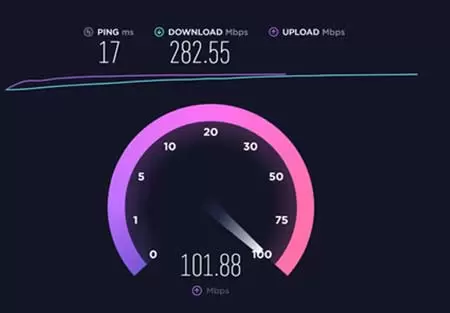What Is Upload Speed?How to test? How much should it be?
What Is Upload Speed?How to test? How much should it be?
Communication is essential. It doesn’t matter whether you’re a bandwidth buff or a newbie looking to gain experience in the field. You all rely on 5G and Wi-Fi waves. Many people use online video streaming facilities and platforms such as Netflix, Disney+, HBO Max, Peacock TV, Hulu, and YouTube. Everyone expects the desired video to be played by pressing the play button at the highest possible speed.
So, if you are suffering from problems such as lousy bandwidth or annoying lag, be aware that we are looking for a solution to eliminate the difference in video download and upload speed. These differences can arise from numerous questions about how, where, and what I should broadcast.
Beginners can use “The Internet Speed Test.” This free site lets you see all your tools’ download speeds, upload speeds, and ping rates. In this way, you can compare the Internet speed with the momentum provided by the Internet Service Provider (ISP).
Well, let’s get to the point. As you know, the upload speed is much lower than the download speed. You don’t have many solutions to solve this problem. This problem existed long ago; your server has always determined the upload speed.
The unit of measurement for upload and download speed is the same in megabits per second (Mbps). Although you cannot control the difference between these speeds, there are ways to improve this difference.
What do you mean by differences?
- Download speed: the data transfer rate from the Internet server to the user’s system.
- Upload speed: the data transfer rate from the user’s computer to the Internet server.
- Symmetrical load: a situation where download and upload speeds are the same.
- ISP: Internet Service Provider (Abbreviation: Internet Service Provider)
- Ping rate: the amount of delay in sending messages between two hosts.
- Bandwidth: The amount of data you can transfer.
In the services provided by most internet providers, the download speed is higher than the upload speed. Of course, after the spread of the Covid-19 pandemic, the demand for harmonizing these speeds also increased. The reason is apparent, the trend of more people working at home, online schools, increased use of streaming and video conferences, etc. This is the current lifestyle.

What is certain is that most people are more interested in downloading or receiving information, playing videos, or searching for faster ways to do this than uploading content. The goal of service providers is to satisfy customers. Access to a suitable bandwidth means fast streaming of movies and songs and, of course, more straightforward use of social networking platforms. A relatively good upload speed may also be acceptable for live video streamers.
Therefore, it can be concluded that some large business sites (Google, Apple, Amazon, Disney, etc.) and social networks (Instagram, Facebook, Tik Tok, Snapchat, etc.) require an internet platform with high upload speed and massive bandwidth. Are. This group of Internet users streams millions of data through their media and various uploads through social networks.
On the other hand, with the ever-increasing tendency of the economic cycle towards home-based businesses and telecommuting, most internet service providers do not show much favor to these large commercial sites.
Test methods
Now let’s see what methods there are to test this issue. By checking the download speed of the system, you can understand that the server sends binary file packages to your computer. Be aware that many sites use Flash to transfer their data. This program usually ignores and does not apply 30% of slow transfers in its test.
The “Bandwidth Place” site uses “HTML5” instead of “Flash” to perform this test. This site provides a faster and more accurate test by eliminating missing data. It doesn’t matter what place you use to perform this test; the important thing is that the site does not use “Flash.” This program is out of date, and its tests are not valid.
The upload test process is done similarly but in reverse. Your computer sends system data to the server to test the upload speed. Your system also takes a series of generic bits and sends them to the server. This data does not contain all the information sent, and the package is encrypted before sending and sent entirely, securely, and anonymously.
Conclusion
download speed
“High-speed” Internet: Internet with a more than 25 Mbps speed. Most internet service providers claim to provide the Internet with a maximum speed of 1000 Mbps. But the results of the tests show that the fastest speed recorded for the Internet of these services is about 150 Mbps. Generally, speeds between 3 and 25 Mbps are considered optimal download speeds.

“Low-speed” Internet: Internet with fewer than 3 Mbps speeds.
Dial-up: Internet with a speed below one megabit per second is called dial-up Internet. Of course, this type of Internet is almost obsolete and so weak that it doesn’t work for streaming, internet searches, or playing online games. This Internet category is calculated in kilobits per second instead of megabits.
Upload speed
“High speed” Internet: speed above 5 Mbps. Most ISPs do not announce the maximum upload speed of their service because this speed is less sensitive than the download speed. Several symmetrical servers have enabled the Internet to provide upload speeds of 150 Mbps, although this is considered unusual. The upload speed between 3 and 5 Mbps is considered standard and enough to meet your daily needs.
“Low speed” internet: speed below one megabit per second. This speed is so low that it can be reduced by kilobytes per second in areas with high user traffic.
If you find that the speed of the internet service is different from what the service provider stated, you can solve this problem by using simple solutions.
First of all, make sure your speed test is done correctly. Sometimes questionable Wi-Fi networks, downloading large files, playing online games, or streaming videos during the test can interfere with the actual result. Therefore, it is necessary to stop all these activities briefly during the trial to have total bandwidth.
Also, before requesting internet service, identify and specify your needs. Some people are looking for high-speed Internet, while maybe they don’t need that much speed. Therefore, it is better to use a lower-level service that suits your needs.
The next step is to use a wireless connection by connecting an Ethernet cable to the modem instead of working with wireless networks. The test results of wired internet networks show that the speed of these networks is always better compared to wireless networks.
And finally, reset your modem. Sometimes using the most traditional way to solve computer problems, i.e., turning the system off and on, brings surprising results.
You can also delete or disable system firewalls during the test (of course, be careful to re-enable them after the test is finished). If after these steps you are still facing the problem of low speed, and you are sure that your hardware or system does not cause it, be sure to contact your internet service provider.

